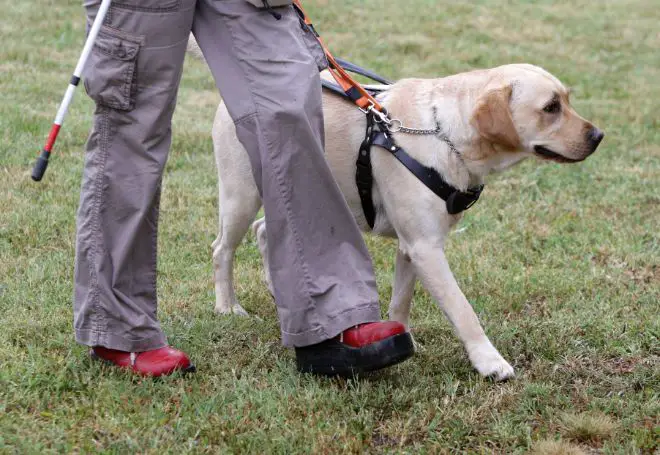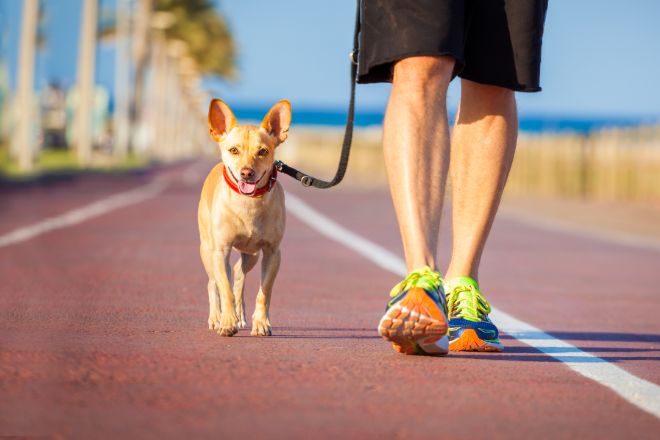One of the most common sights you’ll see on a walk is that of a dog trotting along obediently, sometimes with his owner. It’s not uncommon for this to happen and it usually doesn’t bother people too much–except for when the dog is just walking in circles or taking weird paths. This can be alarming to some people because they don’t know what’s going on.
How to get a stubborn dog to walk on a leash?
One of the most common training mistakes, which is often committed even by experienced dog trainers, is to pull too hard on a dog’s leash. This not only puts tremendous stress on the neck and cervical spine of your pet but also makes it want to stop and fight against you.
As such, you should never try to drag or force your pup out of its comfort zone; instead, use small pulls at the end of the leash as a cue for it to walk with you. You can also employ food treats as an incentive and reward after some time has passed without any pulling on the leash. Before first using them like this though make sure that they are soft enough for your pet to eat easily.
If your dog is still having trouble adjusting to walks on a leash beside you, try starting with a long leash (ten or fifteen feet) and have him stay near you as you slowly move forward. As he gets better at this, gradually decrease the length of the leash until he is walking next to you confidently.

Is it better to walk your dog on a leash or harness?
There are pros and cons to both leashes and harnesses. With a leash, the dog is more likely to stay close to you, but there’s also a greater chance that the leash will become tangled or that the dog will pull against it and choke. With a harness, the dog is less likely to pull against you, but there’s also a greater chance that he can run away if he gets loose. Ultimately, it’s up to you as the pet parent to decide which option is best for your individual dog based on his personality and behavior.

Should you walk your dog off leash?
No. Leash your dog at all times out of respect for themselves and other people on the street. Cities are busy places, and it’s not easy to control a large animal with only a four-foot leash while walking on unforgiving pavement or sidewalk. Not to mention that some dogs can run really fast! A dog on leash will stay within calling distance of the pedestrian while they walk, meaning that if something does happen on an off-leash walk (dog startled by another walker’s dog, robber), the human is able to return their canine friend home without danger of getting lost or hurt in traffic.

How do you train a dog to walk on a leash beside you?
There is no one-size-fits-all answer to this question, as the best way to train a dog to walk on a leash beside you will vary depending on the individual dog’s personality and behavior. However, some tips on how to train a dog to walk on a leash beside you include positive reinforcement such as treats or praise, gradual introduction of the leash and walking together, and patience. Remember that it may take time for your dog to get used to walking on a leash beside you, but with patience and consistency you can successfully train your dog to be by your side when out for walks.
How do you train a dog to walk on a leash without pulling?
A dog can be trained to stop walking forward while on a leash using the following technique, called “forward walking on leash” or “momentum walking.”
1. Attach one end of the leash so it makes six inches of slack in front of your chest.
2. Step away from your dog and walk forward with one foot at a time, so that you create some momentum to encourage him step ahead with his back paw, if he does not do this by himself point your toe under him moving perpendicular to his direction towards his back leg until he steps over it after which you reel in the slack just enough for him to take another step without being choked up all the way or running the risk of him getting tangled up with the leash.
3. If he happens to take a step while you are reeling in the slack or if he pulls on the leash, do not let him move forward, repeat the process from Step 2 until he walks calmly next to you.

Should dogs be on leashes?
Yes, because a leash helps a dog out.
Leashes can be used as a training tool for potential problems with dogs and to make sure the dog stays near you when you’re at the park or on walks outside your house. In both cases, having the dog on a leach makes it easier for you to control them if something should happen that they don’t like — such as meeting an unfamiliar people or pet who doesn’t want to play. A leash also ensures that your pet will not have accidents inside your home which is not only dangerous but smelly too!
The benefits of using a leash include teaching a puppy how to walk confidently and comfortably on one while being held by their owner, positive reinforcement from tugging games that make the dog anticipate and be happy when walks happen, and as a precautionary measure in case the pet runs into dangerous traffic or gets lost. Dogs should always be leashed when outside of their owner’s yard unless in a designated off-leash area.

What age to start leash training a puppy?
Start leash training a puppy as soon as you bring him/her home. Puppies should start leash training between the ages of 8-12 weeks old. It’s important to start early so that your puppy can get used to wearing a collar and leash, and so that you can begin teaching him the basic commands needed for walking on a leash. As with most things in life, the earlier you start, the easier it will be.
Are dogs happier off-leash?
It depends on the dog.
The best way to know if a dog is happy is by assessing their overall behavior and temperament. One way to do this is to observe them when they are off leash or free in a safe area, and see how they react. If the dog seems at ease and displays relaxed behaviors such as sniffing and exploring but doesn’t go too far from you – it could be because they want you close by for reassurance or engagement purposes – then that’s probably a sign that they’re happier off leash. If the dog seems anxious, gets quickly overstimulated, doesn’t come back when called, barks anxiously at other people for no apparent reason, panics every time he sees something new (e.g. a squirrel), or has an overall high-strung temperament, then it’s probably better to keep them on leash in most cases.
The important thing is to always be aware of your dog’s individual needs and preferences, and to make sure that you are providing them with the best possible lifestyle based on those assessments.